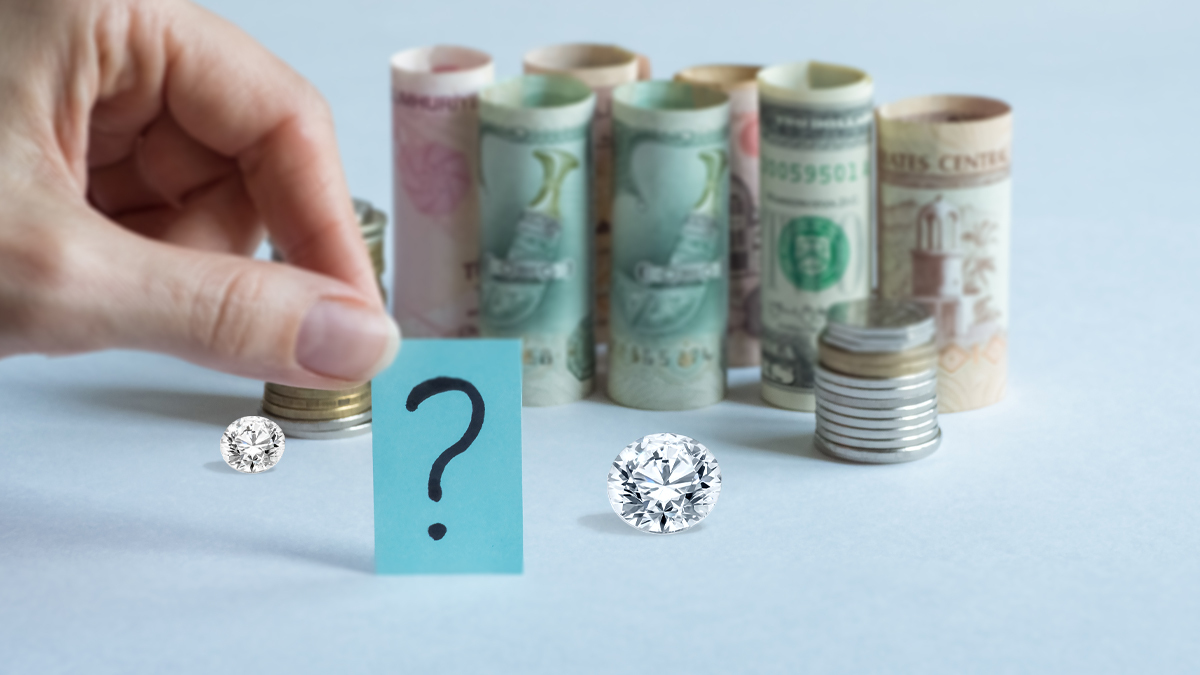Why Are Lab Diamonds Cheaper Than Natural Diamonds?
Lab grown diamonds may be cheap but not in terms of quality, cheaper means in terms of “price”. They have the same properties as natural diamonds whether it’s about look, shine, shape, or clarity, in every character no one can tell if the diamond lab grown or natural without certification. They have the only difference and that is a price tag. In this article, we’ll break down all the reasons why these diamonds are reasonable and what is the science behind this.
Why Are Lab Grown Diamonds Cheaper?
Lab grown diamonds are very appealing, but they usually cost less than natural diamonds. This makes them a better choice for many people who want beauty without spending too much. So, why are lab grown diamonds more affordable than mined diamonds?
The reason is simple. The way they are made and where they come from is different. So, let’s take a look at the reasons that reduce the cost of lab diamonds as compared with mined diamonds.
Controlled Environment Reduces Costs

Producing lab grown diamonds means copying the high pressure and heat conditions that happen deep in the earth’s mantle. This is where natural diamonds form over a long time. Many people think this process uses a lot of energy and resources. However, working in a lab can save a lot of money.
First, labs can fine-tune each step of making diamonds. This way, they avoid the problems and slowdowns that come with mining. There’s no need to search for diamonds, digging tons of rock, or pulling diamonds out of the ground. Also, this controlled setting helps create more gem-quality stones.
In addition, labs use advanced technology and renewable energy sources. This cuts down on production costs and helps the environment. The kind of control and efficiency seen in labs is much better than traditional mining. This leads to big savings when making lab grown diamonds.
Market Demand

Lab diamonds are making a big impact in the diamond industry, especially for engagement rings. Many people, especially millennials and Gen Z, are becoming more aware of the ethical and environmental issues caused by traditional mining. Because of this, they are looking for better options that are more sustainable.
The rise in people wanting lab created diamonds is a big reason why their prices are changing as more buyers choose lab diamonds, production increases. This leads to more competition among the producers. When there’s competition, it helps the buyer by making prices more affordable and providing more options to choose from.
Also, more retailers, including well-known jewelry brands, are starting to accept lab diamonds. This makes lab diamonds easier to find and often leads to better prices. This change in the market is transforming the diamond industry and giving people more choices.
Shorter Supply Chain

The path of a mined diamond from the earth to a buyer’s ring is long and complicated. There are many middlemen involved, and each one adds costs that the final customer must pay. On the other hand, lab created diamonds have a much shorter and clearer supply chain.
They are made in controlled lab environments, so tasks like sorting, cutting, polishing, and even making jewelry often happen in the same place or nearby especially if they are lab grown diamond manufacturers. This shorter process means there are not as many middlemen as with mined diamonds.
Having fewer steps means less transportation and handling, which lowers costs. With fewer chances to raise prices, lab diamonds remain affordable while still being high-quality and beautiful.
No Rarity Factor

A big reason why natural diamonds are so attractive and expensive is their rarity. Mined diamonds are limited in number, and this sense of being scarce has made them desirable and valuable for a long time. Lab grown diamonds change this idea of rarity.
Lab grown diamonds have the same chemical makeup, physical properties, and sparkling beauty as mined diamonds. However, they can be made in large amounts without the same supply restrictions. This ability to produce good quality diamonds in a controlled space takes away the scarcity aspect. As a result, lab grown diamonds are a more affordable choice. Their price is not pushed up by a fake idea of being hard to get. This makes them easier to buy for anyone wanting diamond jewelry.
No Geological Exploration Costs

Finding a diamond deposit that can be mined is a hard and costly job. It takes a lot of time and labor work. This work includes many geological studies, using modern technology, and skilled workers to find, examine, and dig out these gems from the Earth.
The money spent on geological studies raises the price of mined diamonds. In contrast, man made diamonds do not have this cost. By removing this big start-up expense, lab created diamonds become more affordable.
Economies of Scale in Lab Production

Economies of scale are very important in lab production for keeping costs down for lab grown diamonds. When manufacturers make a lot of diamonds in controlled settings, they can lower the cost for each carat. The way lab processes work helps them create high-quality diamonds for less money than mined diamonds. This ability to produce more diamond at a time makes lab diamonds more reasonable for customers.
The Science Behind Lab Grown Diamonds
To understand why lab-grown diamonds are cheaper, we need to look at how they are made. Natural diamonds form over many years deep within the Earth. This may sound hard to copy, but scientists have found a way to do it using technology.
They create the high heat and intense pressure needed for diamonds to form. As a result, labs can create diamonds that have the same chemical makeup, physical traits, and shine as natural diamonds.
How Are Lab Grown Diamonds Made?
Two main ways exist to create stunning lab-grown diamonds: High-Pressure High-Temperature (HPHT) and Chemical Vapor Deposition (CVD). Both methods start with a small piece of a real diamond called a diamond seed.
In the HPHT method, this diamond seed goes into a carbon-rich space. It then faces very high pressure and heat, like the conditions deep inside the Earth. As the carbon melts from this heat, it sticks to the seed. This process helps to grow a bigger diamond crystal layer by layer.
The CVD method is different but leads to the same result: a real diamond. In this approach, a vacuum chamber surrounds the diamond seed. It is exposed to a carbon-rich gas plasma at very high temperatures. When the plasma breaks down, carbon atoms attach to the diamond seed. This builds up the diamond’s structure slowly, layer by layer.
Lab Grown vs Natural Diamonds: What’s the Difference?
To the naked eye or even with a jeweler’s loupe, it is nearly impossible to tell differnce between lab diamonds vs natural ones. They have the same properties. Both types shine brightly and look beautiful in jewelry.
The main difference is how they are made and their origin. Natural diamonds form over billions of years deep in the Earth’s crust. They undergo intense pressure and high temperatures. This process can create unique marks and flaws that show their natural history.
Lab diamonds are made in a controlled setting that mimics the conditions of nature but much faster. Because of this, they are usually more pure and have fewer internal marks. However, this does not change how beautiful or brilliant they are.
Breaking Down the Cost of Lab Grown Diamonds
The cost of lab grown diamonds is appealing to those who want luxury without spending too much. Knowing why they are cheaper than mined diamonds helps show their value.
Lab grown diamonds save money by avoiding mining costs like digging and searching. They also have a shorter supply chain and make better use of resources, which changes the traditional diamond market.
Technology Costs vs Mining Costs
Creating the right conditions for growing diamonds in a lab needs a big upfront investment in technology. Still, this cost is much smaller than the long-term expenses linked to traditional diamond mining.
Mining takes a lot of resources. This includes heavy machines, workers, and electricity. The steps of looking for diamonds, taking them out, and processing them use many resources. They are also affected by things we can’t predict, like the weather, the land’s make-up, and changes in the market.
On the other hand, lab grown diamond production gives better control and predictability. After the first investment in tech, labs can make diamonds more efficiently and consistently. They can also use renewable energy sources like solar and wind power. This helps to lessen their environmental impact and lower their costs, making lab grown diamonds a more sustainable choice.
Pricing Transparency and Market Trends
One important thing about the man made diamond market is how clear the prices are. Lab diamonds usually have simple pricing, unlike mined diamonds, which can have confusing and hidden costs.
This clarity helps people make better choices. They can easily compare prices from different sellers and producers. It also builds more trust. This trust is a big reason why more people are choosing lab grown diamonds.
As technology improves, the cost of making these diamonds is likely to go down even more. This means lab grown diamonds will be easier for people to buy. With prices dropping and more people understanding and wanting these diamonds, the diamond market is changing.
Are Lab Grown Diamonds a Good Investment?
The topic of investment comes up when we talk about lab grown diamonds. They have the same look and make-up as mined diamonds, but their resale market is still growing. It’s important to remember that very few diamonds, no matter where they come from, get a lot more valuable over time.
The main worth of lab grown diamonds is in their beauty, how they are sourced, and their lower prices. If you want a beautiful and ethical choice instead of mined diamonds without the extra cost, lab grown diamonds are a great choice. However, if you are thinking about diamonds mainly as a way to make money, other options might work better for you.
Resale Value of Lab Grown Diamonds
The market for lab grown diamonds is still new. It takes time to figure out a steady resale value for them. Mined diamonds have a long history of resale, but lab grown diamonds are still finding their place.
Factors like carat weight, cut, color, and clarity are important when setting the resale value of lab grown diamonds, just as they are for mined diamonds. Still, things like brand reputation, technology, and the way consumers view these diamonds can also affect their resale value.
When buying a lab grown diamond, especially for a diamond engagement ring, it’s important to know that its resale value may not match that of a similar mined diamond. However, as the market grows and more people accept lab grown diamonds, the resale value should become more stable in the next few years.
The Future of Lab Grown Diamonds
The rise of lab-grown diamonds is changing the diamond industry. It shows us a possible future where sourcing is ethical, sustainability matters, and prices are lower. As technology keeps getting better, the way we make diamonds will be more efficient. This means we will see higher quality diamonds at easier prices.
People are becoming more aware, and their demand is helping this change. Younger generations care more about ethical and sustainable choices. Lab-grown diamonds can catch their interest and might soon be their top choice for diamond jewelry. The future for lab grown diamonds looks promising. Innovation and growth can go far, thanks to human creativity and effort.
Frequently Asked Questions
Are lab diamonds as good as real diamonds?
Yes, lab diamonds are real diamonds. They have the same chemical, physical, and optical features as mined diamonds. They are not like diamond simulants, such as cubic zirconia. Lab diamonds are truly 100% real diamonds that are just created in a different setting.

